
|
|

July 1, 1941 - June 12, 2009
The End
It took a little longer than originally planned, and it hit some bumps along the way, but the long road to the end of full-power analog television in the United States comes to its conclusion today, bringing to a close more than 68 years of the NTSC broadcast standard.
And after all our travels in recent months to chronicle the waning days of analog TV, in the end there was just one place to be when the clock ran out: right here at home, watching the TV stations I grew up with leave the analog airwaves for good.
That process began back in February, when Rochester's newest full-power TV station, WUHF-TV 31, became the first to end its analog broadcasts, but it got underway in earnest early Friday morning atop Pinnacle Hill, in the adjoining buildings of WHAM-TV (Channel 13) and WHEC-TV (Channel 10).
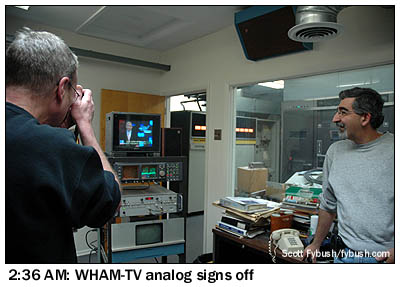
|
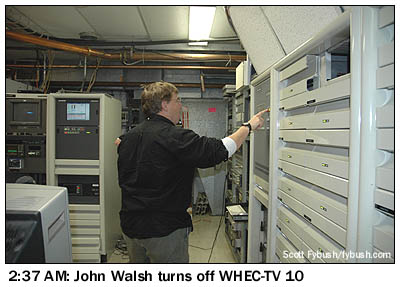
|
Both stations' plans to coordinate a shutdown of analog around 1:30 AM were thrown for a loop by a late-running basketball game on ABC that pushed back WHAM-TV's late-night schedule, so there was an extra hour or so of waiting before things started rolling. On WHAM-TV, the end of "Jimmy Kimmel" led into a taped message from general manager Chuck Samuels reminding viewers to rescan their DTV boxes to pick up WHAM's relocated digital signal - and with the push of a button from master control, analog channel 13 was gone from the Rochester airwaves after almost 47 years.
Just over a minute later in the next building over, there was somewhat less ceremony as chief engineer John Walsh took WHEC-TV's channel 10 analog signal off the air after more than 55 years.
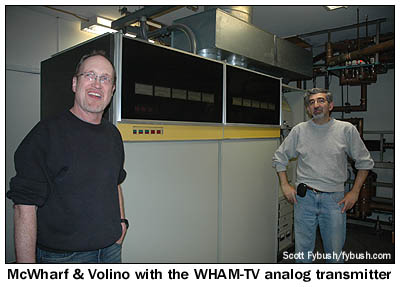
|

|
The rest of WHAM-TV's transition went quickly: engineer Lou Volino and his retired colleague Ted McWharf moved the necessary patches, WHAM-DT channel 13 took to the airwaves, and the temporary WHAM-DT 59 quietly disappeared, leaving a building filled with silent transmitters - the RCA G-line transmitter that had kept 13 humming for a quarter-century, the vintage RCA TT-11 that preceded it, and the channel 59 transmitter downstairs.
Next door, though, things were a little more complex: because WHEC's channel 10 shares an antenna with WROC-TV on channel 8, and because channel 8's analog remained on the air through the end of the day on Friday, some quick work was needed to install a notch filter to prevent WROC's analog signal from feeding back into the WHEC-DT transmitter. All told, it took about 17 minutes before Walsh and his colleague Greg Carter were able to turn on WHEC-DT on channel 10, using one set of cabinets from the old Harris Platinum analog transmitter and a new control cabinet. (That's the WHEC-DT 58 transmitter, now silent, just over Greg's left shoulder in the photo below.)
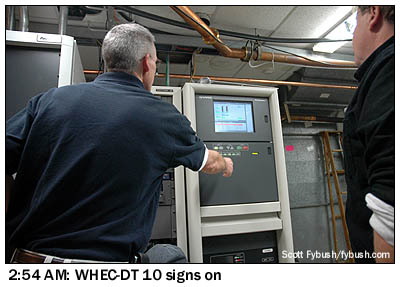
|

|
With most of the Rochester analog TV dial dark, and the remaining stations not ready to move for a while (WXXI-TV 21 went to nightlight at 8 AM, leaving just WROC-TV to stick it out to the end of the day), there was still more to see on this final day of analog TV, 70 miles or so down the road in the Buffalo market.
Four Buffalo TV stations - WIVB-TV 4, WKBW-TV 7, WNLO-TV 23 and WPXJ-TV 51 - planned to shut down at 9 AM, and it was easy to pick one place to be at that moment. WIVB was Buffalo's first TV station, signing on back in 1948 as WBEN-TV, and its 1952-vintage transmitter site in Colden, in the hills south of town, is the market's oldest as well.
We pulled up with about ten minutes to spare, just long enough to see transmitter engineer Clint Soemann being interviewed for WIVB's newscasts - and then the pushing of the button, the thud of the relays, and the end of 61 years of broadcasting on channel 4 in western New York. (This was a simple transition: WIVB-DT 39 continued on its existing facility with no further intervention needed.)
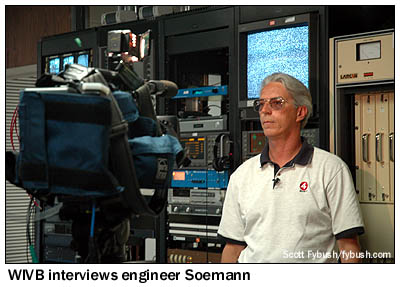
|
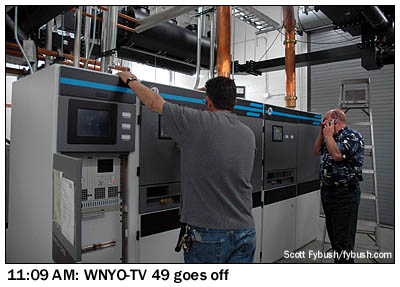
|
Just two Buffalo-market signals remained as we pulled out of the WIVB driveway: WNYO-TV (Channel 49) and WGRZ-TV (Channel 2). With the latter station making a last-minute decision to go nightlight as of 1 PM, that left just WNYO - and just enough time to head over to its transmitter location on a golf course in western Wyoming County to watch chief engineer Bruce Wilde and director of engineering Don Stewart pull off an interesting transition.
WNYO-DT had been operating an interim digital facility on channel 34 from the Grand Island transmitter site of sister station WUTV (Channel 29), but issues with Canadian allocations made that a poor choice for a permanent facility - so with just days to go before the transition, WNYO applied for, and was granted, a move back to channel 49 from the Cowlesville analog site. It took some quick work to install a new digital exciter and convert one of the cabinets of the Acrodyne analog transmitter, but a few minutes after 11:00 it was all ready to go, as Wilde (left) turned off the analog cabinet and Stewart (right) put WNYO-DT 49 on the air. From its site east of Buffalo, WNYO-DT delivers a substantial signal to Rochester as well.
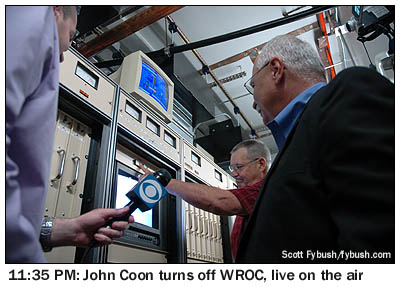
|
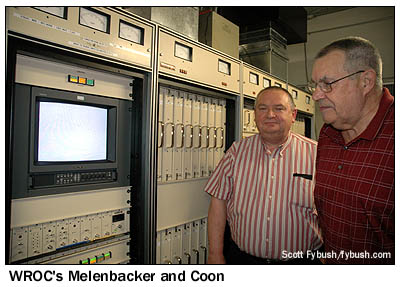
|
And that left just one: the station that brought TV to Rochester 60 years and one day ago was the last signal on the air with analog programming in the market. What's now WROC-TV (Channel 8) was WHAM-TV on channel 6 when it lit up its first transmitter in the building on Pinnacle Hill on June 11, 1949, and retired chief engineer John Coon says he remembers watching that first broadcast as a child. He ended up spending many years at the station, retiring not long after installing the Larcan solid-state transmitter WROC now uses, and the station was thoughtful enough to invite him up to the hill to do the honors at the end of News 8's 11 PM broadcast.
It was a crowded room by the time Coon got to press the button, what with WROC reporter Evan Axelbank (at left in the photo above) and his photographer, GM Louis Gattozzi (looking on at right as the button is pushed), current chief engineer Eric Melenbacker and his assistant, plus the usual contingent of engineers from the neighboring stations on Pinnacle Hill, all here to mark the end of an era as Rochester's first analog signal became its last.
(Well, almost...there's still that nightlight operation on WXXI-TV's analog channel 21, and we'll most certainly be back up on Pinnacle Hill on July 10 to see that go dark, too.)
Got photos of your local stations pushing the button? Send them along, and we'll run them in next week's Tower Site of the Week...
- Previous Site of the Week: Analog TV in Elmira, Utica and Albany
- Next Week: Analogs Turn Off (part II)
- Site of the Week INDEX!
- How can you help support Site of the Week? Click here!
- Submit your suggestions for a future Site of the Week!
